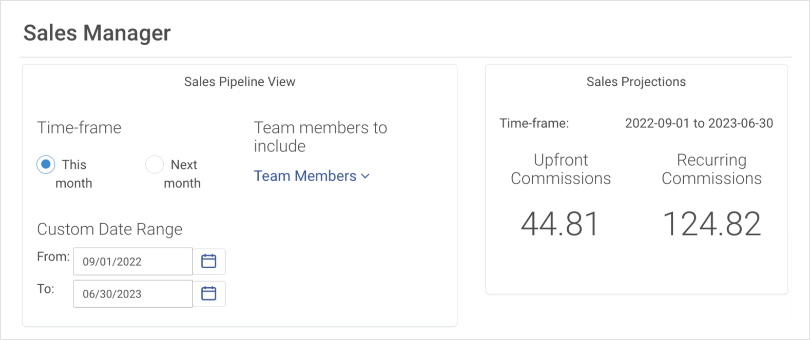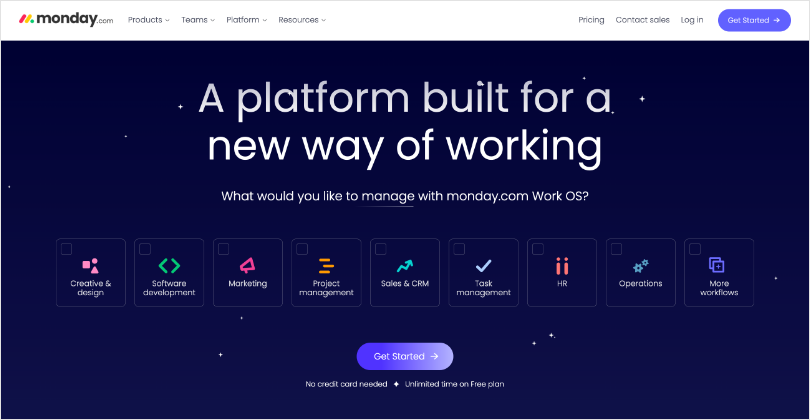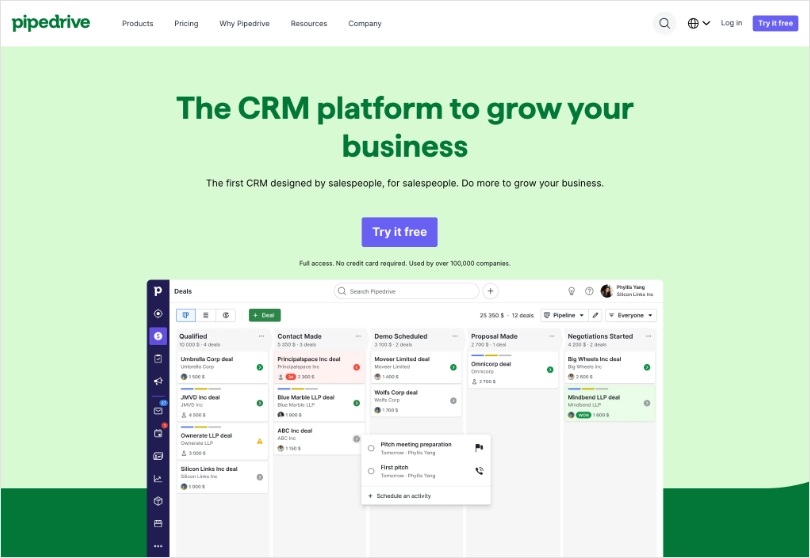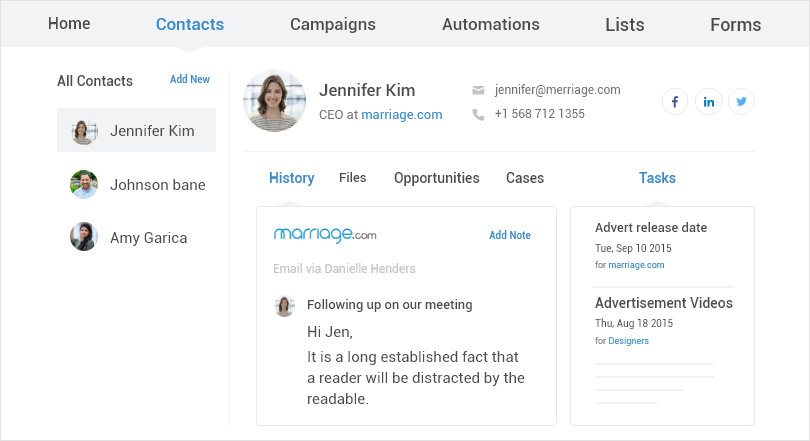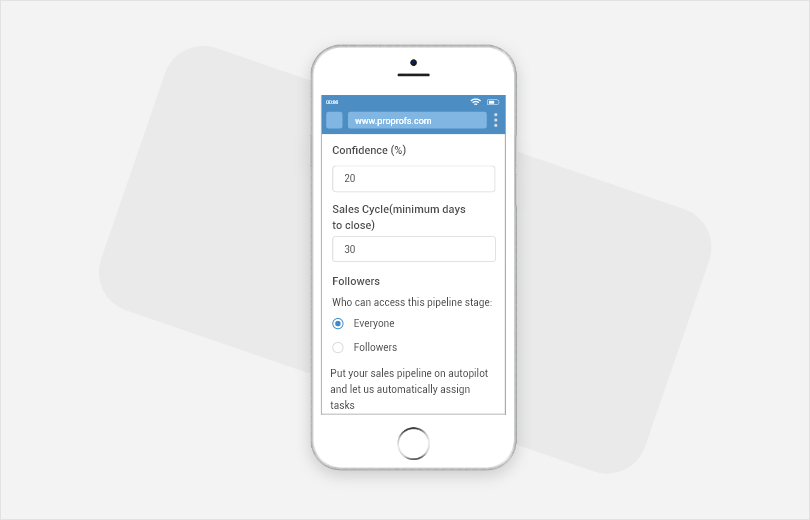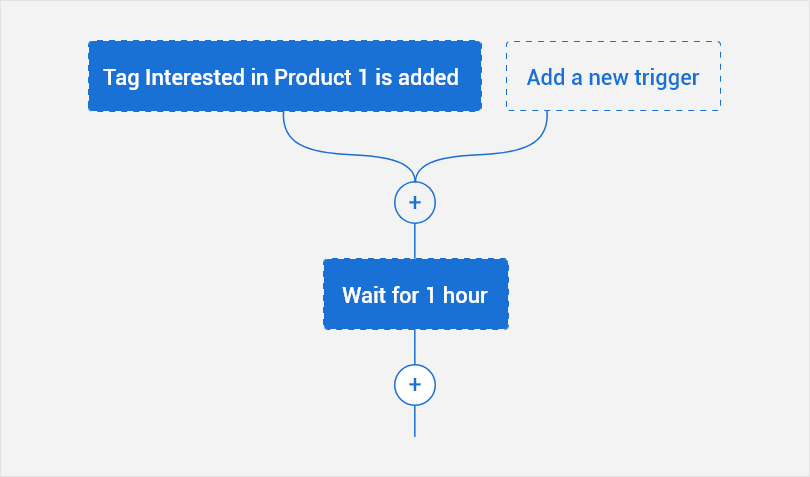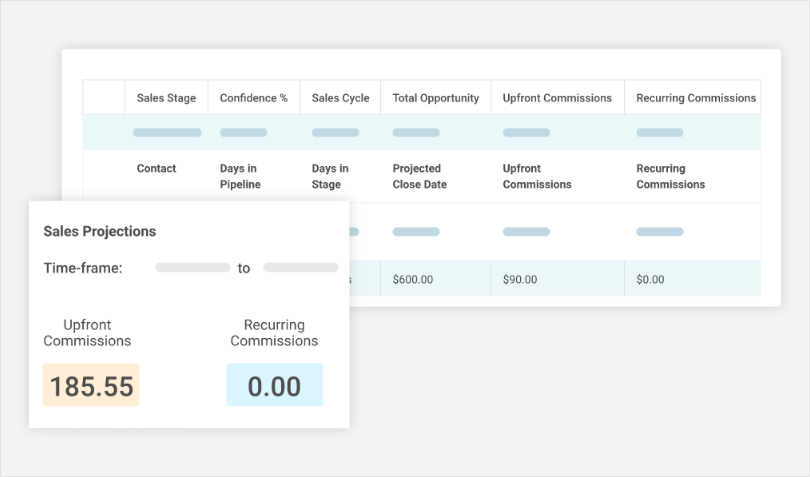Not seeing actual profits despite a constant influx of sales leads? Sales lead management might just be what you need!
Whether it’s a critical detail that you couldn’t get your hands on or a follow-up email that you were too busy to send, there’s a lot that can go wrong with your sales process. So, to ensure maximum efficiency and avoid major losses due to such errors, you must manage sales leads efficiently.
Sales lead management is a strategic process that considers the leads’ activity and optimizes the selling pitch to ensure conversion. For effective management, you must understand your ideal customers, find leads that match this persona, and nurture them effectively.
Lead management may seem overwhelming at first, but it can be highly rewarding with the right strategy and tools. This blog covers 10 tips on managing sales leads and keeping them moving through the sales cycle to bring in more revenue. We also compare the 5 best lead tracking and management software that you can deploy for the same.
In a Nutshell
- Sales leads include all individuals or organizations that express interest in your business and can eventually turn into clients.
- In a rush to continuously bring in more leads, many businesses overlook how these leads are being managed.
- Disorganization of leads can hamper your sales team’s efficiency and sales performance. Without an effective sales leads management system in place, all your leads will go haywire.
- This blog covers the 10 best practices for managing sales leads efficiently. We also list the 5 best software for lead management and compare them to help you find the most suitable solution.
What is Sales Lead Management
Sales lead management encompasses activities ranging from lead generation to conversion. This process involves all the efforts that go into tracking and managing potential customers.
Lead management is a crucial process for businesses to effectively manage their sales pipeline. It involves identifying, capturing, nurturing, and qualifying potential customers and then passing them on to the sales team to close the deal.
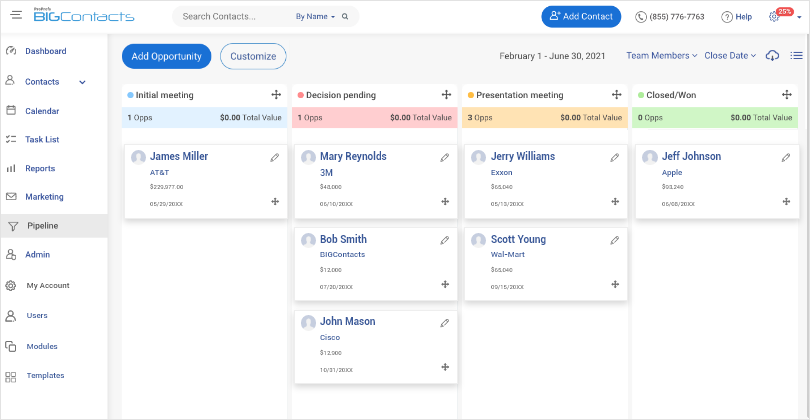
The goal of lead management is to increase conversion rates and revenue by providing sales reps with high-quality leads that are most likely to result in a sale. This process also includes lead scoring, lead nurturing through targeted marketing campaigns, and lead tracking to measure the effectiveness of different lead sources. Effective sales lead management can help businesses streamline their sales process and generate more revenue.
Benefits of Sales Lead Management
Sales lead management, if done right, presents a wide array of advantages. Some of the most significant of these are listed below.
Focus on the Right Deals
Your sales profitability comes down to how well you can manage leads. Effective organization and qualification of leads can bring order to the sales process. It can help salespeople identify higher-value deals. By zeroing in on these prospects, lead management can bring in more revenue.
Achieve Better Productivity
Your sales team can maximize productivity by implementing an effective lead management process. By devoting time and attention to leads more likely to convert, sales representatives can close more deals and drive more profits for the company.
Nurture Leads Effectively
Lead management can considerably affect your bottom line. Tracking the needs of your prospects to optimize your engagement can ensure that more leads are converted into sales.
Read More: 8 Lead Nurturing Best Practices to Boost Your Sales
Improve Team Performance
With a sales lead organizer in place, all your team members can access updated data, such as previous interactions, purchasing preferences, etc., to offer a better quality service. It can aid collaboration and help teams across the organization communicate effectively.
3 Stages of the Sales Lead Management Process
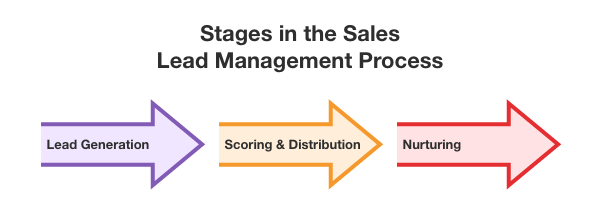
1. Lead Generation
The first step to lead management is generating enough leads for your team to work on. These leads can be gathered when prospects show interest through various marketing channels, including social media platforms, websites, PR events, etc. You must also acquire adequate information about these leads, including their preferences and how your business can solve their problems using online forms or surveys.
Read More: Lead Generation Tools: 28 Options to Consider in 2025
2. Scoring & Distribution
Once you have a steady stream of incoming leads, you need to categorize and prioritize them based on the likelihood of their conversion. Create segmented lists of your leads based on their score, source, close probability, or any other criteria of your liking. Once this classification is complete, you must assign the leads to the most appropriate salesperson for a quick follow-up.
3. Nurturing
Lead nurturing refers to the actions that help convert leads into customers. Since leads are not likely to make the purchase decision right after the first impression, your sales team needs to contact them regularly with relevant follow-ups. Automated email campaigns for lead nurturing are, thus, integral to the overall success of your sales management efforts.
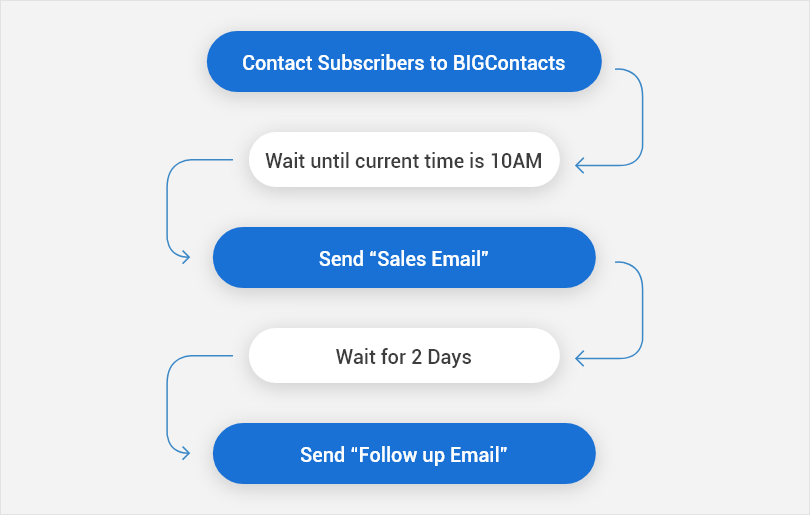
How to Generate Sales Leads
Essentially, any individual or organization that has the potential of converting into your client is termed a sales lead. Leads must display some interest in your product or service and should intend to buy it.
There are multiple channels to acquire leads for your business, including-
- Web Forms: You can create web forms and connect them with your CRM system to capture and store more leads effortlessly.
- Popups: Use exit popup software to collect high-quality leads from your website by engaging with visitors at the most appropriate time. Here, you can find some website popup examples which you can use for your website.
- Cold emails: Emails to potential clients are a proven solution for businesses to gather sales leads. Send out personalized and well-timed emails to capture leads for your business.
- Advertising: Use Pay-per-click advertising to gather more traction for your business.
- Offline events: You can organize networking events to meet people related to your business and industry. This will help you generate leads offline.
- Webinars: Webinars work as an excellent lead generation channel. Collect leads and their information by getting people to sign up by hosting webinars that pique their interest.
- Live chat: Adding a live chat widget to your website can also help acquire qualified leads. With this, you can engage with website visitors and collect relevant information to grow your lead database.
- Referrals: Loyal customers can help you gain more leads by providing you with more referrals. Set up reward programs to encourage more recommendations from existing customers.
- Social media: Use social media to keep track of what people are saying about your business and identify high-value prospects with ease.
10 Tips to Manage Sales Leads
Following are 10 best practices that you can implement to see your leads translate into actual profits for your business.
1. Know Your Prospects
Not knowing what qualifies as a lead is one of the biggest productivity challenges for businesses. Your sales and marketing teams must be on the same page regarding what they consider a qualified lead.
Setting clear guidelines and references for your sales and marketing professionals can help you access leads that match your expectations and avoid wasting time on prospects unwilling to make a purchase. Before organizing sales leads, you should devote adequate time to define what a lead means for your sales team clearly.
2. Identify Lead Sources
Be aware of where most leads are coming from to identify what channels work best for your business. This can help you utilize your marketing budget more judiciously.
Your lead sources could include paid advertising, offline marketing channels, social media, etc. By keeping an eye on which lead generation channels are performing well, you can ensure that your resources are put to good use.
3. Invest in a Sales Lead Manager
A sales lead management system such as a CRM can align your sales objectives with your business operations. CRM lead management can bring all your data to one platform, allowing your sales team to access it readily.
It can also help personalize your interactions with the leads to improve your closing rate. With an effective lead management system, you can ensure that no lead goes unnoticed. A CRM tool can also automate multiple processes to enhance your lead nurturing efforts.
Read More: What is Lead Management in CRM?
4. Collect Information From Prospects
You need to have access to relevant information to manage sales leads efficiently. This information can be obtained through forms, surveys, or any other form of interaction. Collecting this data is crucial to keeping your marketing and sales activities aligned with the leads’ expectations.
This information can also help you assign and distribute leads more effectively, leading to better sales lead management. It can enable your sales team better understand the leads and modify their approach accordingly.
5. Segment Leads Effectively
Segmentation is critical for effective management. Divide leads based on specific criteria, their interests, or any actions taken by them. You can also score leads based on their characteristic behavior with the help of lead-tracking solutions. This can help you separate hot leads from the rest.
Classifying leads can help your sales representatives identify which leads require more attention. You can segment the leads based on what information they are seeking or their online activity, such as downloading an attachment, filling out forms, etc.
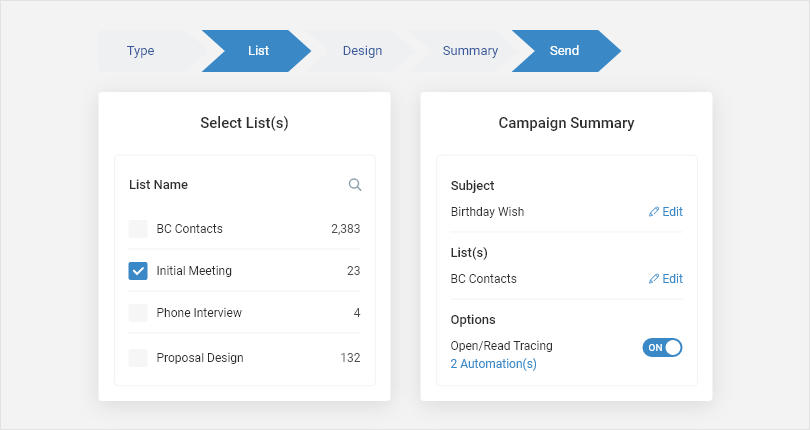
6. Assign Leads Timely
Longer lead response time can lead to a 15% increase in your churn rate.
This brings to light the importance of the timely distribution of leads.
Responding to leads quickly can establish a credible position for your business. The leads can get relevant information on time, which makes for a better experience. If you do not want your leads going cold, be quick and efficient while assigning them to salespeople.
7. Include Lead Nurturing Content
Leads need sufficient time and effort to be ready to make the purchase decision. To expedite this process, you need effective lead nurturing.
For this, you need to include relevant supporting content in your management strategy. This can help improve your drip campaigns and guide more leads toward conversion. Personalized marketing content can reduce the length of your sales cycle and boost your conversion rate.
8. Monitor Your Performance
Keep a close eye on how your lead management strategy is performing and incorporate changes whenever necessary.
You need to decide which metrics are the most important to track. Hold regular meetings with your sales team to identify roadblocks and make the required adjustments in your management strategy. You can use a CRM tool to generate custom reports to track various metrics, such as sales cycle length, acquisition cost, etc., to track the effectiveness of your sales activities.
9. Focus on Forming Relationships
If you wish to make the most out of all the available leads, you must adopt a more personalized approach. Treating every prospect as a customer can help you gain more loyalty and form long-lasting relationships.
Be responsive, helpful, and accommodating when interacting with prospects. Effective engagement is a critical component of lead management. If you continue to treat leads as just numbers, they are likely to switch to a competitor that is more involved and interested in them. To avoid this, you need to ensure that your leads know how much value they carry for your business.
10. Strive for Continuous Improvement
“Growth and comfort do not coexist” – Ginni Rometty, IBM CEO.
Your lead management strategy has to evolve continuously as your business continues to expand.
With time, your lead sources, buyer persona, and other associated factors are likely to change. It is imperative that your lead management strategy changes with it. Adaptability can keep lead management solutions functional for a long time.
Top 5 Lead Management Software
We have made your search for the best lead management software easier by rounding up the 10 best tools and comparing their features. Explore the pros and cons of these tools to find the most suitable solution for your business.
1. BIGContacts – Best for contact management & email marketing for small & medium businesses
If you require an all-inclusive solution that works well for your contact management, lead tracking, business automation, and analytics needs, BIGContacts is the one to go for. This intuitive lead management CRM helps you track the movement of leads through the sales funnel using a visual pipeline. It also helps nurture more leads with targeted and automated email sequences.
Key Features:
- Create a custom sales pipeline and manage leads using a drag-and-drop interface
- Track sales performance using a range of standard and custom reports
- Craft automated workflows and sequences to keep leads moving forward
- Sort and filter through leads for effective targeting and prioritization
- Track all the related data and interactions for leads from a single place
What is Unique About BIGContacts
- Follow-up with leads at the right time with automatic alerts and reminders
- Manage sales leads on the go using any mobile device
Pricing:
- Forever free plan for startups with all premium features.
- Paid plan starts at $9.99/month.
2. monday.com – Best CRM for project management/ team collaboration
monday.com helps centralize and manage sales leads, contributing to an improvement in your business’s bottom line. You can use it to automate your sales communication, which results in more conversions and enhanced customer loyalty. The tool logs all lead activity automatically, offers powerful sales analytics, and helps you save time with pre-built email templates that are easy to customize.
Key Features:
- View contact details, priority status, notes, and other associated information for leads in one place
- Score leads based on any attributes of your choice
- Use custom dashboards to track the most relevant sales metrics
- Get instant alerts for lead activity to engage at the right time
- Capture leads using web forms, import them from other applications, or add them manually
What is Unique About monday.com, Why We Picked It:
- Identify and merge duplicate contact records with ease
- Connect the platform with DocuSign, Mailchimp, LinkedIn, and several other business applications
Pricing:
- Starts from $10/user/month
Read More: Top Monday.com Sales CRM Alternatives
3. Pipedrive – Best for sales-focused teams
Pipedrive CRM is an effective solution for sales lead management with its powerful lead generation and prioritization features. All the incoming leads are stored in a central lead inbox, making qualification and tracking easier. The tool also provides detailed timelines for lead activity. Use Pipedrive to group and filter your leads for more effective management.
Key Features:
- Use visual and intuitive sales pipelines to manage leads
- Lead records are populated with contact information available online
- Track visitor’s web activity and capture high-quality leads using the sales prospector
- Unify all conversations, including messages from Facebook and WhatsApp
- Filter, sort, and qualify leads for more effective management
What is Unique About Pipedrive, Why We Picked It:
- Use tags and labels to organize sales leads
- Capture high-quality leads from live chat, chatbots, and web forms
Pricing:
- Starts from $9.90/user/month
4. Zendesk Sell – Integrates CRM with existing Zendesk support
Zendesk Sell lets you gain complete visibility into your sales pipeline, so you can manage leads more effectively. Drive more personalized interactions with your prospects by accessing all the related data from a single platform. The tool unifies contact and deal management, so you don’t have to jump between applications to manage your operations.
Key Features:
- Manage your sales lead using a visual pipeline
- Set up email and task sequences to improve lead nurturing
- Use pre-built analytics reports and dashboards to monitor sales performance
- Stay connected with leads on the go using the mobile app
- Boost productivity by setting up automated tasks and custom triggers
What is Unique About Zendesk, Why We Picked It:
- Sync with Gmail or Outlook to stay on top of all conversations
- Segment your leads using filters and lists
Pricing:
- Starts from $19/user/month
5. Keap – Sales & marketing automation for small/medium businesses
Keap CRM lets you manage your leads from start to finish using a drag-and-drop sales pipeline. You can also use it to acquire high-quality leads, automate follow-ups, and analyze sales performance. Keap also enriches contact records, helping you personalize your interactions with leads. The tool also provides powerful lead-scoring functionality, so you can focus your attention on high-value prospects.
Key Features:
- Create multiple custom pipelines to manage sales leads
- Trigger automated follow-ups and tasks to improve lead nurturing
- Visualize important metrics using reports and dashboards
- Use tags and lead scores for effective prioritization
- Manage invoices and payments without leaving the system
What is Unique About Keap, Why We Picked It:
- Generate qualified leads with landing pages, forms, and lead magnets
- Enable leads to book appointments with you at their convenience
Pricing:
- Starts from $149/month
Read More: List of Free Lead Management CRM Software For 2025
Leveraging CRM for Effective Lead Management
Let’s take a deeper dive into how any of the lead management tool can help you manage your sales leads.
Pipeline Management
A CRM tool can help you manage your leads by visualizing the entire sales pipeline, from initial contact to closed deals. This feature lets you see where each lead is in the sales process, what tasks need to be done to move them to the next stage, and which deals are likely to close soon.
Team Collaboration
CRM software allows your team to share information and collaborate on tasks related to lead management. This feature can help your team work more efficiently and effectively, especially if they are working remotely or in different locations.
Contact Management
A CRM application can help you manage your leads by providing a centralized database of contact information, including names, addresses, phone numbers, and email addresses. Contact management software can help you stay organized by managing your contacts and ensuring that you have all the essential information at your fingertips.
Mobile Access
A CRM can provide mobile access, which means that you can manage your leads from anywhere, at any time. This feature can be especially useful for salespeople who are frequently on the road and need to access lead information from their mobile devices.
Lead Scoring
CRM can use lead scoring to prioritize leads based on their likelihood to convert into customers. This feature can help you focus your efforts on the leads that are most likely to result in sales, which can save you time and resources.
Automated Emails
CRM tools can help you stay in touch with your leads by sending automated emails at key points in the sales process. This feature can help you nurture your leads and keep them engaged with your brand.
Reports
CRM software can provide you with detailed reports on various metrics related to lead management, such as the number of leads generated, the conversion rate, the sales cycle length, and the revenue generated from leads. These insights can help you identify bottlenecks in your sales process and make data-driven decisions.
In summary, a CRM tool can help you manage your leads effectively by providing a centralized database of information, visualizing the sales pipeline, generating reports, allowing team collaboration, providing mobile access, prioritizing leads, and automating email communication. With CRM, you can streamline your lead management process, improve your sales efficiency, and increase your revenue.
Drive Better Sales Outcomes With Lead Management
If you are tired of losing promising opportunities to competitors, it’s time you focus on how your sales leads are being managed.
While the answer to how to manage sales leads may vary for different enterprises, they all require one thing in common- a powerful sales lead management tool. Such a tool can help generate, qualify, nurture, and track sales leads. In addition, it can provide centralized access to essential information related to prospects, allowing sales representatives to optimize their sales pitches.
For this, you need a functional, easy-to-navigate, scalable, and adaptable tool. An example of this is BIGContacts. This CRM software can help optimize your sales management efforts to drive more conversions and revenue. You can also use its automation capabilities to get things done quickly and efficiently, leading to delightful customer experiences.
FREE. All Features. FOREVER!
Try our Forever FREE account with all premium features!


